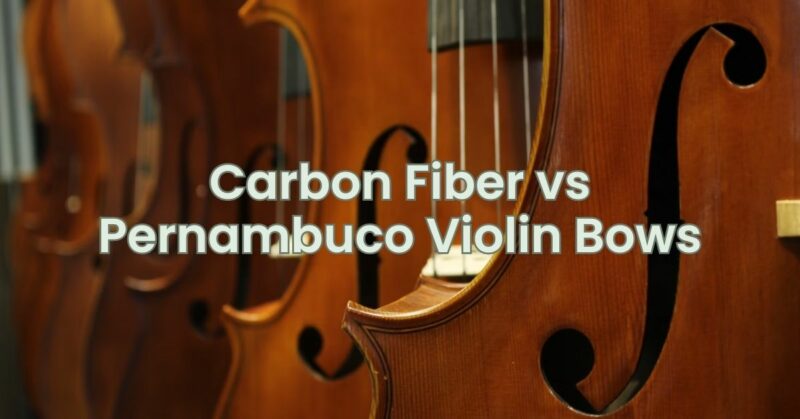When it comes to selecting a violin bow, musicians are often faced with the choice between a carbon fiber bow or a traditional pernambuco wood bow. Both options offer distinct characteristics and advantages. In this article, we will compare carbon fiber and pernambuco violin bows, shedding light on their differences to help you make an informed decision based on your playing style, preferences, and budget.
Carbon Fiber Violin Bows: Carbon fiber bows have gained popularity in recent years, offering modern alternatives to traditional wood bows. Let’s explore some key advantages and considerations:
- Durability and Stability: Carbon fiber bows are highly durable and resistant to warping, humidity, and temperature changes. They are less prone to damage compared to pernambuco wood bows, making them a reliable choice for musicians who frequently travel or perform in varying environmental conditions.
- Consistency and Predictability: Carbon fiber bows are manufactured with precision, resulting in consistent weight, balance, and performance. This uniformity provides musicians with predictable playing characteristics, allowing for reliable and consistent sound production.
- Lower Maintenance: Carbon fiber bows require minimal maintenance compared to wood bows. They are less affected by humidity, temperature, and rosin buildup, reducing the need for frequent rehairing and cleaning. This can save time and maintenance costs in the long run.
- Affordability: Carbon fiber bows are generally more affordable than high-quality pernambuco wood bows. They offer a cost-effective option for musicians seeking a reliable and well-performing bow within a more modest budget.
Pernambuco Violin Bows: Pernambuco wood bows have been a standard choice for violinists for centuries. Let’s explore some key advantages and considerations:
- Warmth and Tonality: Pernambuco wood bows are known for producing warm and rich tones. They possess a unique character that can enhance the expressiveness and depth of a musician’s playing. Many professional violinists appreciate the tonal qualities and nuances that pernambuco bows offer.
- Flexibility and Responsiveness: Pernambuco bows are typically more flexible compared to carbon fiber bows. This flexibility allows for a wide range of dynamics, articulations, and tonal colors, providing musicians with greater versatility in their playing.
- Traditional Craftsmanship: Pernambuco bows often exhibit intricate craftsmanship and attention to detail. The natural aesthetics of pernambuco wood, coupled with the historical significance of these bows, can be appealing to musicians who value traditional craftsmanship and the instrument’s heritage.
- Sensitivity to Environmental Factors: Pernambuco wood bows are more sensitive to changes in temperature and humidity. They require regular maintenance, including rehairing and proper care, to ensure optimal performance. Musicians using pernambuco bows must be mindful of these factors and take appropriate measures to protect the bow’s integrity.
Conclusion: Choosing between a carbon fiber and pernambuco violin bow depends on your personal preferences, playing style, and budget. Carbon fiber bows offer durability, stability, consistency, and affordability, making them a practical choice for many violinists. Pernambuco wood bows, on the other hand, provide warmth, tonal richness, flexibility, and a traditional aesthetic that appeals to those seeking a deep connection with tradition and craftsmanship.
Consider trying out different bows, if possible, to experience firsthand the differences in feel, sound, and playability. Seeking guidance from a music teacher or an experienced violinist can also provide valuable insights to help you make an informed decision. Ultimately, whether you choose a carbon fiber or pernambuco violin bow, selecting a well-crafted and appropriate bow that suits your needs will enhance your playing experience and allow you to express your musicality with confidence and precision.

